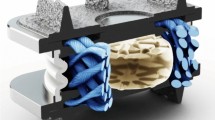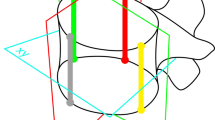Summary
Background: In the case of a 32-year old female patient with multiple hereditary exostosis, diagnosis and treatment of the combination of cervical osteochondroma of the C5 neural arch with additional growth deformation of the C6 arch is presented. Additional bisegmental posttraumatic instability of C4–6 with osteophytes caused an asymmetric 2/3 stenosis of the spinal canal.
Methods: Under slow progression of tetraparetic symptoms, CT and MRI defined the extent of spinal canal stenosis, the points of origin of osteochondroma and osteophytes. Percutaneous diskography documented the posttraumatic damage of the C4–6 intervertebral disks. Wide resection of the C5 arch with the osteochondroma and partial resection of the growth-deformed C6 arch was done in the first phase. 3 weeks later, ventral spondylodesis of unstable segments C4–6 with resection of osteophytes brought immediate relief of neck pain and gradual regression of neurological deficits. The dysesthesias in the right Th4–5 dermatomes ceased after the C4–7 facet blockades.
Results: The 5-year postoperative follow-up revealed no recurrence of osteochondroma in the spinal region.
Conclusions: Surgical treatment in 2 acts with maximum prevention of additional spinal cord compression, and the stabilization of posttraumatic and additional postresection instability is decisive.
Zusammenfassung
Grundlagen: Im Falle einer 32jährigen Patientin mit multipler angeborener Exostose stellen wir Diagnose und Behandlung einer Kombination von Halswirbelsäulenosteochondrom des C5-Nervenbogens mit einer zusätzlichen Wachstumsdeformation des C6-Bogens vor. Die zusätzliche zweisegmentige posttraumatische Instabilität des C4–6 mit Osteophyten verursachte eine asymmetrische 2/3-Verengung des Spinalkanals.
Methodik: Bei langsamer Progredienz tetraparetischer Symptome definierte das CT- und MRI-Verfahren das Ausmaß der Spinalkanalverengung, die Ursprungspunkte von Osteochondrom und Osteophyten. Die perkutane Diskographie stellte eine posttraumatische Schädigung der C4–6-Bandscheiben dar. Eine breite Resektion des C5-Bogens mit dem Osteochondrom und Teilresektion des wachstumsdeformierten C6-Bogens wurde in der ersten Phase durchgeführt. 3 Wochen später brachte eine ventrale Spondylodese der instabilen Segmente C4–6 mit Resektion der Osteophyten eine sofortige Linderung der Nackenschmerzen und allmählich Regression neurologischer Defizite. Die Dysästhesien in den rechten Th4–5-Dermatomen hörten nach den C4–7-Facettenblockaden auf.
Ergebnisse: Während der 5jährigen postoperativen Nachbeobachtungszeit wurde kein Osteochondromrezidiv in der Spinalgegend entdeckt.
Schlußfolgerungen: Die chirurgische Behandlung in 2 Akten mit maximalen Maßnahmen gegen eine zusätzliche Rückenmarkkompression sowie die Stabilisierung der posttraumatischen- und zusätzlichen Postresektionsinstabilität ist ausschlaggebend.
Similar content being viewed by others
References
Albrecht S, Crutchfield JS, Segall GK: On spinal osteochondromas. J Neurosurg 1992;77:247–252.
Barros-Filho TE, Oliveira RP, Taricco MA, et al: Hereditary multiple exostoses and cervical ventral protuberance causing dysphagia. A case report. Spine 1995;20:1640–1642.
Bonica JJ, Loeser JD, Chapman CR, Fordyce WE: The management of pain. 2nd ed. Vol II. Philadelphia-London, Lea & Febiger, 1990, pp 1138–1139.
Cherubino P, Benazzo F, Castelli C: Osteochondroma of the cervical spine. Ital J Orthop Traumatol 1991;17:131–134.
Cooke RS, Cumming WJK, Cowie RA: Osteochondroma of the cervical spine: case report and review of the literature. Br J Neurosurg 1994;8:359–363.
Dahlin DC, Unni KK: Bone Tumours: General Aspects and Data on 8542 Cases. 4th ed. Springfield/IL, Charles C. Thomas, 1986, pp 18–32.
Decker R, Wei W: Thoracic cord compression from multiple hereditary exostoses associated with cerebellar astrocytoma. J Neurosurg 1969;30:310–312.
Eaton BA, Kettner NW, Essman JB: Solitary osteochondroma of the cervical spine. J Manipulative Physiol Ther 1995;18:250–253.
Fanney D, Tehranzadeh J, Quencer R: Case Report. Osteochondroma of the cervical spine. Skeletal Radiol 1987;16(2):415.
Ferrari G, Taddei L, Vivenza C, et al.: Paraparesis in hereditary multiple exostosis. Case report. Neurology 1979;29:973–977.
Fielding W, Ratzan S: Osteochondroma of the cervical spine. J Bone Joint Surg 1973;55A:640–641.
Haritidis J, Tsikouriadis P, Tsakonas A: Osteochondroma of the cervical spine. Case report. Chir Organi Mov 1993;78:251–253.
Inglis AE, Rubin RM, Lewis RJ, et al: Osteochondroma of the cervical spine. Case report. Clin Orthop 1977;126:127–129.
Jackson A, Hughes D, St Clair-Forbes W, et al: A case of osteochondroma of the cervical spine. Skeletal Radiol 1995;24:235–237.
Jaffe H: Hereditary multiple exostoses with myelopathy. Arch Neurol 1979;36:714.
Linkowski GD, Tsai FY, Recher L, et al: Solitary osteochondroma with spinal cord compression. Surg Neurol 1985;23:388–390.
MacGee EE: Osteochondroma of the cervical spine: a cause of transient quadriplegia. Neurosurgery 1979;4:259–260.
Madigan R, Worrall T, McClain EJ: Cervical cord compression in hereditary multiple exostoses. Review of the literature and report of a case. J Bone Surg 1974;56A:401–404.
Malat J, Viraponse C, Levine A: Solitary osteochondroma of the spine. Spine 1986;11:625–628.
Morard M, de Preux J. Solitary osteochondroma presenting as a neck mass with spinal cord compression syndrome. Surg Neurol 1992;37:402–405.
O’Brien MF, Bridwell KH, Lenke LG, et al.: Intracanalicular Osteochondroma Producing Spinal Cord Compression in Hereditary Multiple Exostoses. J Spinal Disord 1994;7:236–241.
Prasad A, Renjen PN, Prasad ML, et al: Solitary spinal osteochondroma causing neural syndromes. Paraplegia 1992;30:678–680.
Roman G: Hereditary multiple exostoses, a rare cause of spinal cord compression. Spine 1978;3:230–233.
Schwartz HS, Pinto M: Osteoblastomas of the Cervical Spine. J Spinal Disord 1990;3:179–182.
Thomas ML, Andress MR: Osteochondroma of the cervical spine causing cord compression. Br J Radiol 1971;44:549–550.
Author information
Authors and Affiliations
Rights and permissions
About this article
Cite this article
Vrabl, M. Osteochondroma of the cervical spine in combination with chronic posttraumatic bisegmental instability. Acta Chir Austriaca 29, 160 (1997). https://doi.org/10.1007/BF02619779
Issue Date:
DOI: https://doi.org/10.1007/BF02619779




